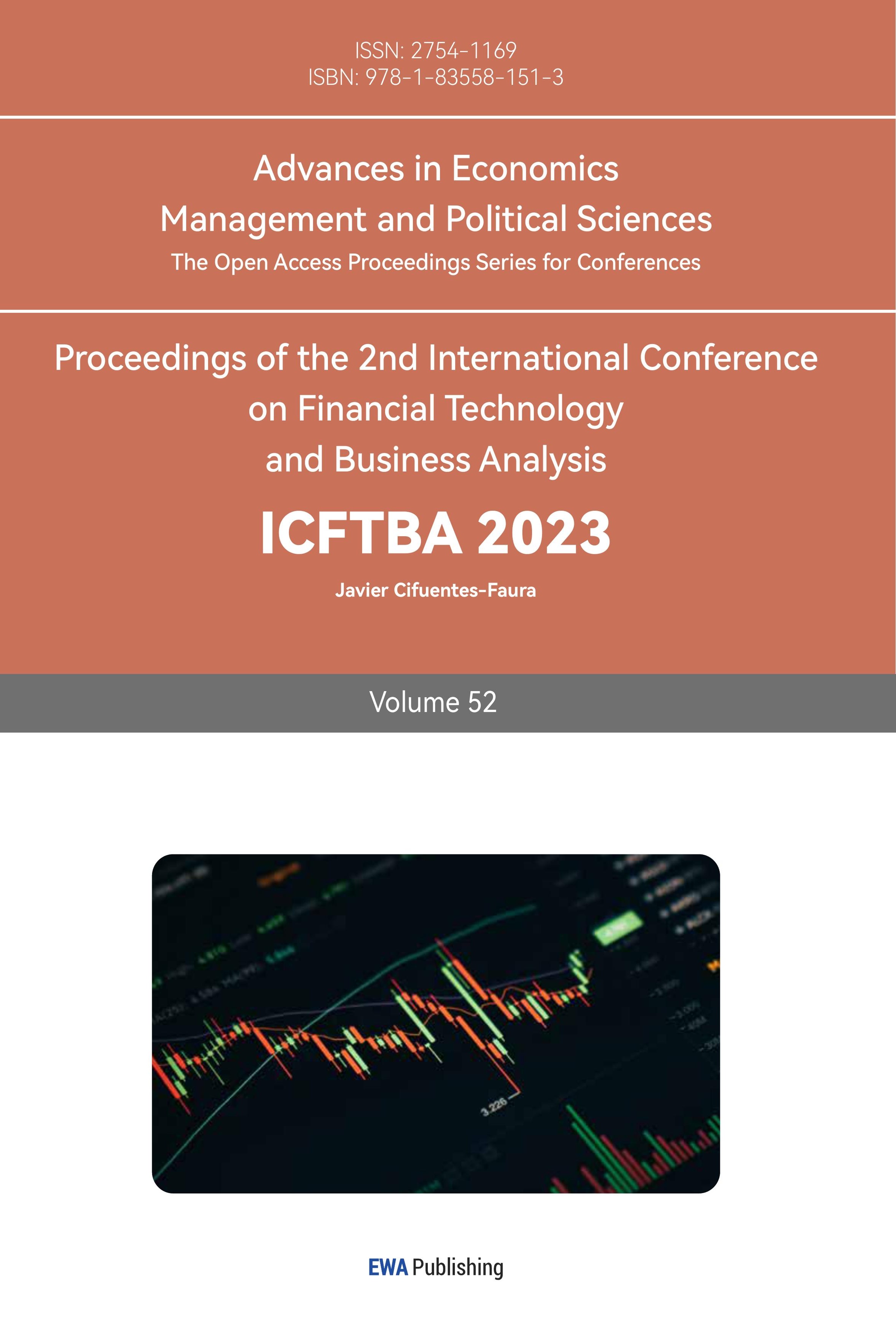1. Introduction
The break-out of the Russia-Ukraine war captures the attention of the world. As the largest war after World War II in Europe, the multifaceted impact ensnared the fascination of people around the world. Though climate change is one of the hottest topics in the current era, there is hardly a comprehensive view of the result of the war on climate change. In previous research on the impact of war on climate change, most institutions and individuals including Chatham House [1] focused on the direct war impact on climate change by discussing the carbon emission related to the resultant destruction of the ecosystem and reconstruction needed after the war, but ignore the long-term effect of the war that may post on transformation of energy structure and advancement of renewables. This article aims to find out the war’s effect on climate change in general, provide a more diverse perspective on war and climate change, and take a comprehensive view of the Russia-Ukraine war. At the same time, this paper provides a potential hypothesis that illustrates the mechanism behind the recurring armed conflict and war that occurred in those energy-rich countries in order to supplement a special factor that may strengthen and prolong the effect of the war on climate change.
2. Destruction on the Environment and Extra Energy Consumption
The direct impact of the Russia-Ukraine war follows the enormous destruction of infrastructure, mass depletion of photosynthetic plants, extra energy spent on the production of weapons, and disturbance of international trade routes and flights for avoiding the risk of war. Firstly, the intentional assault on hostile civil facilities, infrastructure, and factories will pose a threat to massive leakage of the greenhouse. According to Danish Energy Agency [2], the carbon emissions from the Nord Stream incident alone have reached 32% of Denmark’s national carbon emissions for an entire year. Not to mention the intentional bombings of each other’s factories which are excellent targets for carbon leakage and releasing other toxic chemical substances to the environment like sulfur dioxide the main contributor to acid rain, causing extensive deforestation on a grand scale. In addition, the large demand for military equipment drives both sides and their behind-the-scenes weapons suppliers’ heavy industry which are heavily carbon-consuming to operate at breakneck speed, involving the onstage and backstage conflict of the two world’s most powerful conglomerates in weapon manufacturing. Furthermore, the war also causes extra disturbance to international routes and flights, forcing them to take longer trips and higher prices for carbon emissions. Lastly, due to the special status of the main exporter of natural gas for the EU as a cleaner energy for replacing coal, the war and sanctions forced the EU to readopt some coal plants for tiding Europeans over the severe winter, thereby generating extra carbon emission. The amount of electricity relied on the coal-fired standby can reach 13.5GW [3]. By taking those into account, according to the report of CNN [4], the primary estimation submitted to the UN is 120 million metric tons unleashed in the first 12 months of the war due to direct war destruction.
3. Acceleration of Advanced Technology
Besides, war usually will be attributed to the increment in the price of oil and other energy resources. Firstly, if it occurred in major fossil fuel production countries or countries that control the crucial oil transport corridor like the Hormuz Strait during the conflict between Iran and US, war will directly influence the supply side of oil and result in the increase of oil price globally. The temporary paralysis of current oil and gas transportation due to wars in transit countries’ territories or waters, rushing to purchase oil driven by the panic caused by war, war occurring in major oil-producing countries resulting in losses to oil facilities and workers, and sanctions posted toward or posted by certain energy importing country will lead to the energy crisis. For the demand side, oil is the primary energy resource for operating the war machine. During the war, the tremendous need for oil and corresponding sanction will lead the oil price up a level. On the one hand, the energy crisis will compel countries that relied on importing energy to transform to other more pollutant energy that they might abandon before, carbon emission rises in the short run. On the other hand, the energy crisis makes countries become more focused on renewable energy as a main source of energy for concerns of energy security so that they can reduce dynamic costs, which refers to spillovers those investments have for the future costs of emission reduction [5], by investing in more efficient and economical ways to take advantage of sustainable energy. The Russia-Ukraine war facilitates the increment of determination of European countries to diversify their energy sources. One of the major actions and plans driven by war is REPowerEU. According to the EU Commission in 2022, they manage to double the additional deployment of renewables after the breakout of the war. This plan aims to accelerate the rollout of renewables, saving energy, reducing fossil fuel consumption in industry and transport, and Diversifying supplies [6]. The overall effect increases the goal of EU renewable power from 40% to 45% renewables in the EU mix [7]. Simplifying permitting for major renewable projects and expanding the scale of renewables promised in REPowerEU decrease the dynamic cost which will benefit dealing with climate change as a long-term challenge.
However, the effect on energy structure will be a long-term effect. As a result, it needs to take a similar situation in history to investigate and prove the actual effect on facilitating the advancement of energy structure. A similar action in dealing with the abrupt cessation of a major energy resource caused by the war in history is the first oil crisis caused by Yom Kippur War.
On the one side, the war and sanctions derived from energy-dominant countries stimulate the flourishing development of the energy-saving industry. Take the first oil crisis to exemplify. The first oil crisis decreases the reliance of the US on oil by enacting fuel-efficient policies exemplified by the birth of energy conservation law. Smaller, more fuel-efficient, and more efficient cars in Japan are increasingly favored by people. The establishment of the International Energy Agency is benefited from the war and resultant sanctions under the leadership of US. According to relevant research, since 1974, the level of energy consumption in the economies of IEA member countries has decreased by 32%, and oil consumption has decreased by 80% [8]. The crisis notably drops the per capita carbon dioxide emission in US from a rapid increment to a significant reduction, benefiting from gaining momentum of energy-saving technologies because of the soaring oil prices [9], as shown in Figure 1.
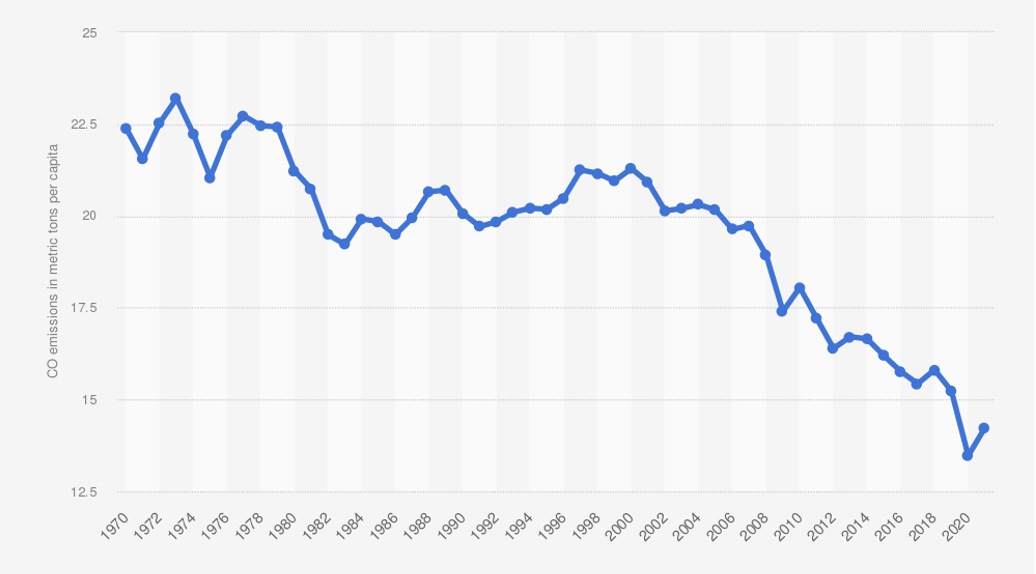
Figure 1: Per capita carbon dioxide emission from fossil fuels in the United States from 1970 to 2021 (in metric tons, source: Statista.com).
On the other side, typically, the war and corresponding embargo will force corresponding countries to invest more money in substitute renewables. Japan in the first oil crisis is the best example to illustrate this aspect. Due to the resultant oil embargo of the Yom Kippur War in middle east in 1973, the Japanese government launched a plan called the sunshine project, mainly focusing on replacing oil in its energy structure. According to Table 1, the war and embargo push the Japanese government to spend 70.16B yen on renewables from 1974 to 1981 [10]. The history of hydrogen energy in Japan started with the sunshine project under the background of the first oil crisis in 1974. The main focus was solar energy and geothermal energy. Under the support of the Sunshine Project, relevant research and technologies have flourished and developed vigorously. The dynamic cost is considerably significant after the Sunshine project. For solar power, from 1974 to 1989, the cost of solar power per watt decreased from 20,000 Japanese yen to 720 Japanese yen. For hydrogen power, in 1984, Japan successfully completed the research and development of high-temperature, high-pressure alkaline water electrolysis for hydrogen energy. For geothermal energy, exploring Geothermal Resource Reserves, Establishing Optimal Exploration Methods, and Developing High-Temperature Rock Geothermal Power Generation Technology to Reduce Development Costs and Determine the Best Excavation Methods. In 1989, the Sunlight Project has achieved a low-carbon energy supply equivalent to 690 thousand barrels of oil, approximately 1.4% of the whole energy supply of Japan. Oil in energy structure tremendously decreased from 77.4% in 1974 to 57.9% in 1989 [11]. All these contributions base the status of Japan as one of the most advanced countries in the world nowadays, especially in Hydrogen and geothermal energy. Besides, the spillover benefit of reducing carbon emissions to the future brought by the advancement of technology in renewables is countless and considerable.
Table 1: Transition of budget related to Sunshine project (unit in 100 million yen).
1974 | 1975 | 1976 | 1977 | 1978 | 1979 | 1980 | 1974-1980 | 1981 | |
Solar | 8.5 | 11.0 | 14.5 | 14.5 | 20.5 | 38.0 | 95.5 | 202.5 | 79.9 |
Geothermal | 5.5 | 11.0 | 15.5 | 25.5 | 32.0 | 35.5 | 86.0 | 211.0 | 98.2 |
Coal | 4.0 | 8.5 | 9.0 | 10.5 | 14.5 | 29.0 | 86.0 | 161.5 | 135.5 |
Hydrogen | 3.5 | 4.5 | 4.5 | 5.0 | 6.0 | 7.0 | 9.5 | 40.0 | 9.5 |
Other Supports | 2.5 | 4.5 | 5.5 | 6.5 | 8.5 | 10.0 | 9.5 | 47.0 | 13.5 |
Total | 24.0 | 39.5 | 49.0 | 62.0 | 81.5 | 119.5 | 286.5 | 662.0 | 336.6 |
Source: Sunshine Engineering Promotion Headquarters Agency of Industrial Science and Technology Ministry of International Trade and Industry | |||||||||
In the same year 1973 in Japan, nuclear power, an important clean energy, begin to be recognized as a national strategic priority [12]. Subsequently, nuclear power takes on the primary electricity generation responsibilities in Japan. At its peak in 2011, nuclear power overtook over 30% of Japan’s electricity generation. Figure 2 shows the development of nuclear power in Japan.

Figure 2: Operable nuclear power capacity in Japan from 1970 to 2023 (in megawatt electrical, source: World Nuclear Association).
Therefore, in this case, on the other side, once a war occurred, especially involved with major fossil fuel export countries, the increment of price in those fossil fuel markets will incentivize the government to invest and value R&D of clean energy as a substitute for those fossil fuels in the future. Those research projects not only will expand the scope of clean energy immediately but also will reduce the dynamic cost of reducing carbon emissions.
4. Continuous and Cyclical Effect of War
In a country where fossil fuel export is dominant in its economy, the price of oil and war can easily get the country into a negative cycle especially when the country possess political dictatorship. In the prospering time of the fossil fuel market, the high price of oil intensifies the ambition of the dictator in the country. The country will be more aggressive, launching war on its neighbor. They will produce more fossil fuel before or at the very beginning of the wartime if there is no sanction since the internal demand for fossil fuel for the army increases and more money is needed to support the war. Once the war started, the income from fossil fuel will immediately drop since production is inhibited due to the destruction of infrastructure for transportation and sanctions. Due to the unjustifiability of the war, it usually suffered from persistent resistance by local residents and international aid to the declared enemy country.
When a war reaches a prolonged stalemate and the benefits gained from the war fall far short of the wealth lost due to the conflict, a nation may find itself burdened with massive debt. In the event of war failure, reparations must also be shouldered. Additionally, the nation must engage in domestic reconstruction following the war, necessitating a substantial influx of funds. To address economic challenges, the government must ramp up energy exports to earn foreign exchange. This deepens the nation’s economic reliance on energy, as other industries have been decimated by the war, leaving energy as a focal point for recovery.
However, if the nation experiences a prolonged downturn in international energy prices, its economy could collapse. Under such circumstances, suppressed political and ethnic tensions, inherent in autocratic regimes, are exacerbated, causing a decline in national cohesion. This may lead to internal conflict or even dissolution, particularly for countries subjected to long-term authoritarian rule, where issues tend to fester rather than being openly addressed. Alternatively, the nation might adopt a strategy of perpetual war to sustain its existence.
In either case, the likelihood of armed conflict remains high. Without external assistance, the nation becomes increasingly dependent on fossil fuels. Yet, as global demand for fossil fuels continues to decline, exploration efforts and the development of new energy sources such as shale oil and methane hydrates in other regions increase supply. This perpetuates a cycle of war and poverty, ensnaring the nation in a relentless cycle of turmoil.
The cycle can be explained in Figure 3. Historical examples include the Soviet-Afghan War and the Iran-Iraq War. Iraq at the end of the previous century serves as a perfect illustration of this model. With its oil-based economy continuously thriving, Iraq, driven by various geopolitical considerations and under the leadership of its dictator Saddam, initiated the Iran-Iraq War. However, during this conflict, Iran’s continuous attacks on Iraq's oil tankers in the Persian Gulf dealt a severe blow to Iraq's oil-reliant economy. Its revenues plummeted, and the war's expenses forced Iraq to accumulate external debt.
The protracted nature of the war significantly hampered Iraq's economic development and caused substantial damage to its infrastructure. Furthermore, Iraq gained no benefits from the war, failing to achieve any of its intended goals and consequently accumulating a significant debt burden. Compounded by its heavy dependence on oil and the decline in international oil prices, Iraq's economy struggled to cope with its immense debt.
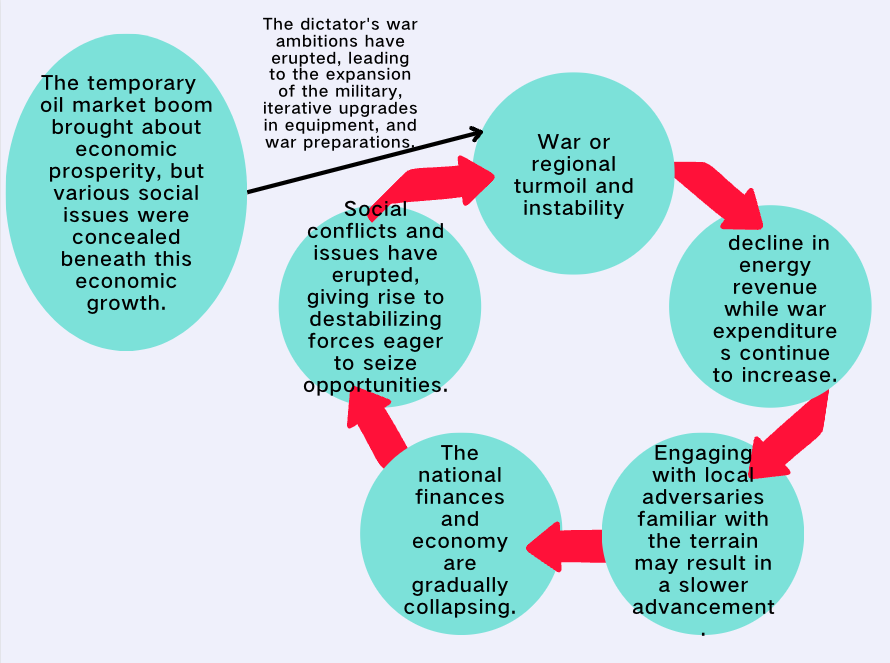
Figure 3: The cycle of war in energy-producing countries (Picture credit: Original).
The vulnerabilities of an energy-dependent economy became starkly evident as Iraq faced difficulties in repaying its debts. To address this dire debt situation, following the Iran-Iraq War, Iraq set its sights on Kuwait, one of its major creditor nations, and launched an invasion of Kuwait in an attempt to resolve its severe debt crisis.
Figure 4 to Figure 6 clearly show Iraq’s Pre-war and Post-war periods situation. The sources of the graphs are from relevant literature [13-15]. They correspondingly show the per capita and its structure, government debt to GDP, and history of the world oil market.
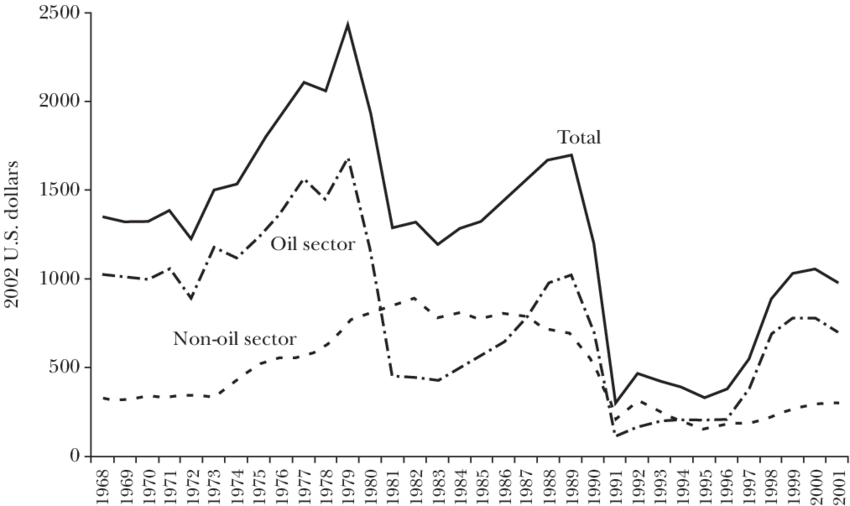
Figure 4: Per Capita GDP in Iraq between 1968 and 2001 (in 2002 US dollars).
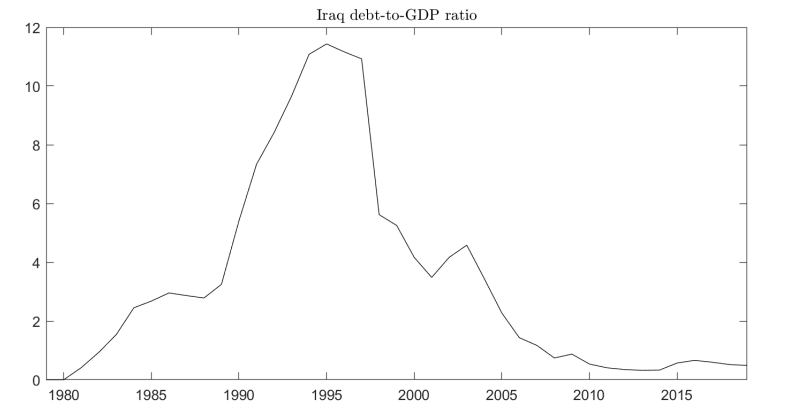
Figure 5: Iraq government debt to GDP ratio (%).
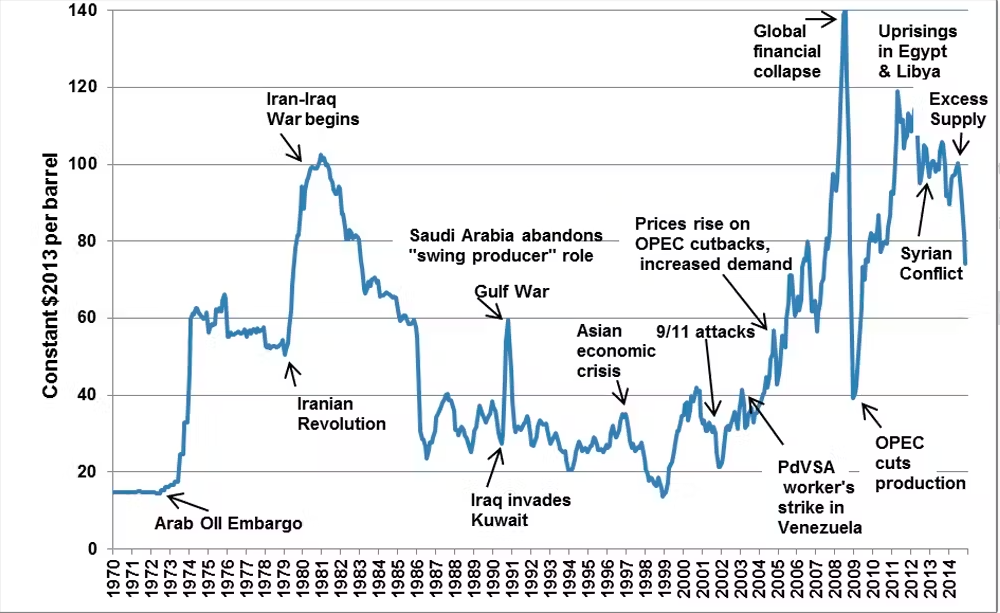
Figure 6: The history of oil market from 1970 to 2014(in value of US dollar in 2013 per barrel, source: Conversation).
As of today, Iraq’s economy remains heavily reliant on oil exports, as assessed by the World Bank [16]. Consequently, the shadow of regional instability has not dissipated. In this environment, the Iraqi government has yet to formulate a plan for economic diversification this year. Instead, it has expanded its government structure, with a large bureaucracy plagued by corruption and inefficiency, lurking beneath the façade of Iraq's economic recovery. The model described earlier could still be in operation.
Given these circumstances, if the energy market were to suffer significant setbacks and prolonged declines, such as due to technological revolutions in new energy sources, the social issues mentioned earlier could resurface. These issues have the potential to once again destabilize Iraqi society and even lead to armed conflicts. The war effect on climate change as discussed before will cycle through this feedback.
5. Conclusion
This article analyzes the short-term and long-term impacts of war on climate change. On one hand, in the short term, war leads to increased carbon emissions through the burning of oil in war machinery and destruction of forests due to conflict. It also damages infrastructure and housing, causing additional emissions during reconstruction. On the other hand, wars involving energy-producing nations tend to raise energy prices, encouraging other countries to develop clean and renewable energy sources as alternatives. The text uses the examples of the Russia-Ukraine conflict and the Yom Kippur War to illustrate this point. Finally, the text proposes a cyclic model of war's impact on climate change for countries dependent on energy, using the example of Iraq from the previous century to illustrate how countries caught in such a cycle can experience prolonged wars that contribute to a continuous climate impact. This cycle remains relevant, as countries like present-day Iraq and Russia are still susceptible to this pattern.
However, due to the ongoing nature of the Russia-Ukraine conflict, the extent of war’s impact on long-term new energy development remains uncertain. Additionally, since Russia is also a key exporter of metals crucial for electric vehicle production, the conflict might impede progress in the new energy sector within the context of the Russia-Ukraine conflict. In future research in this field, introducing statistical and computational data on both short-term and long-term effects could provide a more accurate overall conclusion through the study of various individual cases.
References
[1]. Brown, O. (2023). How Russia’s war on Ukraine is threatening climate security. Chatham House.
[2]. Danish Energy Agency. (2022). The possible climate effect of the gas leaks from the Nord Stream 1 and Nord Stream 2 pipelines. København.
[3]. Brown, S. (2022). Coal is not making a comeback: Europe plans limited increase (p. 4). London: Ember.
[4]. Paddison, L. (2023). Russia’s war in Ukraine is undermining global efforts to tackle the climate crisis, new report finds. Cable News Network.
[5]. Gillingham, K., and Stock, J. H. (2018). The Cost of Reducing Greenhouse Gas Emissions. Journal of Economic Perspectives, 32(4), 53–72.
[6]. The European Commission. (2022). REPowerEU: A plan to rapidly reduce dependence on Russian fossil fuels and fast forward the green transition (pp. 1–4). Brussel.
[7]. The European Commission. (2022). REPowerEU: affordable, secure and sustainable energy for Europe (pp. 1–20). Brussels.
[8]. Liu, Y. (2013). The Superpowers’ Decision-Making during the Energy Crisis. Social Sciences Literature Press.
[9]. U.S. fossil CO2 emissions per capita 1970-2021. (2022). Retrieved from https://www.statista.com/statistics/1049662/fossil-us-carbon-dioxide-emissions-per-person/#:~:text=Per%20capita%20CO%E2%82%82%20emissions%20in%20the%20U.S.%201970%2D2021&text=American%20produced%2023.2%20metric%20tons%20of%20carbon%20dioxide.
[10]. Sunshine Engineering Promotion Headquarters Agency of Industrial Science and Technology Ministry of International Trade and Industry. (1981). Japan’s Sunshine Project Solar Energy R&D Program (p. 4).
[11]. Zhang, G. (1991). Implementation of the Sunshine Plan in Japan. International Science and Technology Exchange (08),17-19.
[12]. World Nuclear Association. (2019). Nuclear Power in Japan | Japanese Nuclear Energy - World Nuclear Association. Retrieved from https://world-nuclear.org/information-library/country-profiles/countries-g-n/japan-nuclear-power.aspx
[13]. Foote, C., Block, W., Crane, K., and Gray, S. (2004). Economic Policy and Prospects in Iraq. Journal of Economic Perspectives, 18(3), 47–70
[14]. Hir, S. (2019). Economic History Working Papers Tracing Iraqi Sovereign Debt Through Defaults and Restructuring (p. 3). London: London School of Economics and Political Science.
[15]. Montgomery, S. L. (2022). Oil price shocks have a long history, but today’s situation may be the most complex ever. Retrieved from https://theconversation.com/oil-price-shocks-have-a-long-history-but-todays-situation-may-be-the-most-complex-ever-178861
[16]. The World Bank. (2022). The World Bank in Iraq. Retrieved from https://www.worldbank.org/en/country/iraq/overview#:~:text=Iraq%20is%20one%20of%20the
Cite this article
Xia,S. (2023). The Climate Consequences and the Impact on Energy Structure from National Disputes. Advances in Economics, Management and Political Sciences,52,132-139.
Data availability
The datasets used and/or analyzed during the current study will be available from the authors upon reasonable request.
Disclaimer/Publisher's Note
The statements, opinions and data contained in all publications are solely those of the individual author(s) and contributor(s) and not of EWA Publishing and/or the editor(s). EWA Publishing and/or the editor(s) disclaim responsibility for any injury to people or property resulting from any ideas, methods, instructions or products referred to in the content.
About volume
Volume title: Proceedings of the 2nd International Conference on Financial Technology and Business Analysis
© 2024 by the author(s). Licensee EWA Publishing, Oxford, UK. This article is an open access article distributed under the terms and
conditions of the Creative Commons Attribution (CC BY) license. Authors who
publish this series agree to the following terms:
1. Authors retain copyright and grant the series right of first publication with the work simultaneously licensed under a Creative Commons
Attribution License that allows others to share the work with an acknowledgment of the work's authorship and initial publication in this
series.
2. Authors are able to enter into separate, additional contractual arrangements for the non-exclusive distribution of the series's published
version of the work (e.g., post it to an institutional repository or publish it in a book), with an acknowledgment of its initial
publication in this series.
3. Authors are permitted and encouraged to post their work online (e.g., in institutional repositories or on their website) prior to and
during the submission process, as it can lead to productive exchanges, as well as earlier and greater citation of published work (See
Open access policy for details).
References
[1]. Brown, O. (2023). How Russia’s war on Ukraine is threatening climate security. Chatham House.
[2]. Danish Energy Agency. (2022). The possible climate effect of the gas leaks from the Nord Stream 1 and Nord Stream 2 pipelines. København.
[3]. Brown, S. (2022). Coal is not making a comeback: Europe plans limited increase (p. 4). London: Ember.
[4]. Paddison, L. (2023). Russia’s war in Ukraine is undermining global efforts to tackle the climate crisis, new report finds. Cable News Network.
[5]. Gillingham, K., and Stock, J. H. (2018). The Cost of Reducing Greenhouse Gas Emissions. Journal of Economic Perspectives, 32(4), 53–72.
[6]. The European Commission. (2022). REPowerEU: A plan to rapidly reduce dependence on Russian fossil fuels and fast forward the green transition (pp. 1–4). Brussel.
[7]. The European Commission. (2022). REPowerEU: affordable, secure and sustainable energy for Europe (pp. 1–20). Brussels.
[8]. Liu, Y. (2013). The Superpowers’ Decision-Making during the Energy Crisis. Social Sciences Literature Press.
[9]. U.S. fossil CO2 emissions per capita 1970-2021. (2022). Retrieved from https://www.statista.com/statistics/1049662/fossil-us-carbon-dioxide-emissions-per-person/#:~:text=Per%20capita%20CO%E2%82%82%20emissions%20in%20the%20U.S.%201970%2D2021&text=American%20produced%2023.2%20metric%20tons%20of%20carbon%20dioxide.
[10]. Sunshine Engineering Promotion Headquarters Agency of Industrial Science and Technology Ministry of International Trade and Industry. (1981). Japan’s Sunshine Project Solar Energy R&D Program (p. 4).
[11]. Zhang, G. (1991). Implementation of the Sunshine Plan in Japan. International Science and Technology Exchange (08),17-19.
[12]. World Nuclear Association. (2019). Nuclear Power in Japan | Japanese Nuclear Energy - World Nuclear Association. Retrieved from https://world-nuclear.org/information-library/country-profiles/countries-g-n/japan-nuclear-power.aspx
[13]. Foote, C., Block, W., Crane, K., and Gray, S. (2004). Economic Policy and Prospects in Iraq. Journal of Economic Perspectives, 18(3), 47–70
[14]. Hir, S. (2019). Economic History Working Papers Tracing Iraqi Sovereign Debt Through Defaults and Restructuring (p. 3). London: London School of Economics and Political Science.
[15]. Montgomery, S. L. (2022). Oil price shocks have a long history, but today’s situation may be the most complex ever. Retrieved from https://theconversation.com/oil-price-shocks-have-a-long-history-but-todays-situation-may-be-the-most-complex-ever-178861
[16]. The World Bank. (2022). The World Bank in Iraq. Retrieved from https://www.worldbank.org/en/country/iraq/overview#:~:text=Iraq%20is%20one%20of%20the





